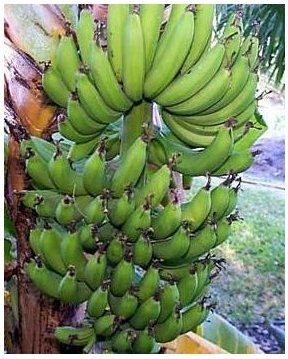Jul 24 2012
The Banana Genome
 Published in Nature this month is a report of the entire genetic sequence of Musa acuminata – the Cavendish banana. The banana is the most popular fruit in the industrialized world. Banana varieties are also an important staple crop in much of the world. The Cavendish, however, is threatened by two fungal infections – Panama disease and black leaf streak disease. Hopefully knowledge gained from the banana genome will lead to new varieties of acuminata that are resistant.
Published in Nature this month is a report of the entire genetic sequence of Musa acuminata – the Cavendish banana. The banana is the most popular fruit in the industrialized world. Banana varieties are also an important staple crop in much of the world. The Cavendish, however, is threatened by two fungal infections – Panama disease and black leaf streak disease. Hopefully knowledge gained from the banana genome will lead to new varieties of acuminata that are resistant.
Part of the problem is that the Cavendish is a highly cultivated variety. Starting about 7,000 years ago the banana was cultivated by hybridization of various varieties. Interestingly, most acuminata varieties are triploid, meaning they have three copies of each chromosome, while some are diploid with two copies. Diploid and triploid varieties were hybridized together.
One trait in particular that was selected for was being seedless. Most banana varieties contain numerous large seeds. The Cavendish has none, which makes it an attractive variety as a dessert fruit. However, this also means that there is no longer any sexual recombination within the Cavendish variety. Every Cavendish banana plant (representing about half of all bananas in the world) is a somaclone derived from the single variety. A somaclone refers to a plant derived ultimately from a single somatic parent cell. This means that every Cavendish banana plant is virtually identical genetically to every other. They are not strictly identical because somaclone variability is possible through spontaneous somatic mutations. But variation is minimal.
The same it true, by the way, in some other cultivated plants, such as grape vines. Vines can be spread by taking a cutting from an adult vine, resulting in a somaclone.
While this may be efficient for industrialized production, having plant cultivars that are largely somaclones has one huge significant downside – the lack of genetic diversity. This means that pests and diseases have the opportunity to evolve to highly efficiently infect and infest the somaclone variety. The Cavendish banana industry is a huge evolutionary opportunity for any fungus, for example, that evolves traits that allow it to infect this common plant. That is exactly what is happening.
This issue goes beyond bananas and even somaclone varieties. Humans have cultivated many species of plants, and those cultivars that have the most desirable traits (including being the most profitable) have tended to predominate. This is happening at the expense of local varieties. As genetic diversity of cultivated plants decreases, they are more susceptible to diseases and blight. This is a serious threat to the sustainability of our crops. Bananas may be the most vulnerable at the moment, but they are not alone in being threatened by disease.
There are possible solutions, however. One easy solution (meaning it does not require any technological or scientific advances) is simply protecting local varieties of cultivated plants. We may need to pay a little extra for these varieties, but it is an important hedge against crop blight.
Sequencing the banana genome is part of a high tech approach to the problem. If somaclones do not contain much genetic diversity, then perhaps we can generate that diversity ourselves. We can cultivate or genetically engineer new varieties to increase genetic diversity, and specifically to provide resistance to emerging threats like Panama disease. Researchers, for example, and sequences DH-Pahang variety of Musa acuminata, an ancestral variety to the Cavendish. DH-Pahang is resistant to the fungal diseases that threatens the Cavendish. If researchers can identify the genes responsible for this resistance and introduce them back into the Cavendish variety, that could result in a new variety that is also resistant.
This may prevent history from repeating itself. A century ago the primary commercial banana variety being shipped to industrial nations was not the Cavendish but the Gros Michel. This was a larger, creamier, and by all accounts better variety of M. acuminata than the Cavendish we have today. It was wiped out (not extinct, but not commercially viable) by the early 1960s, and was replaced with the Cavendish. We got 50 years out of the Cavendish, but now it may go the way of the Gros Michel if it’s not saved.
Perhaps, with some genetic tweaking thanks to the knowledge gained from sequencing the M. acuminata genome, scientists can not only save the Cavendish but bring back the Gros Michel, newly resistant to the fungus that previously wiped it out. That would be something. I have never tried a Gros Michel. Perhaps one day I will be able to buy them at the local supermarket.
Of course, any genetic tweaks we make now will only be a temporary solution, as the fungi are not likely to give up but will continue to evolve and spread in an evolutionary arms race. Long term it seems we need to reverse the practice of depending upon very few cultivars for most of our food production. We need to build greater genetic diversity back into our plant production on a large scale.






